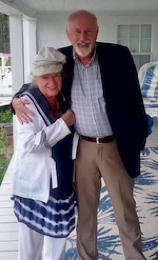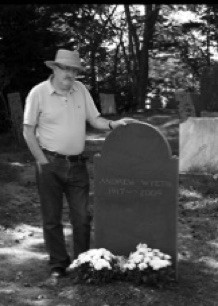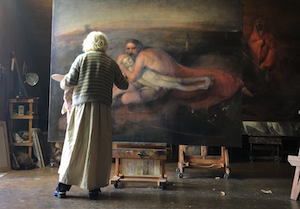Passions & Inspiration
The Grand Tour
I used to tell Sarah that if I ever went missing to search for me first in the prints and drawings study room of the Victoria & Albert Museum in London. There I could hold in my hands the original glowing paintings of the greatest English watercolourists of the nineteenth century: Cox and Callow, Bonnington and Boys and Prout. Many of the works were made on the artists’ romantic Grand Tour across Europe to Venice and Florence and Siena, inspired by the revelations of John Ruskin’s Stones of Venice. I followed them to Venice several times, lost in the light of another world drawing the Ca’ D’Oro on the Grand Canal, or the Byzantine basilica of San Marco (right), trying to see them through Ruskin’s or Callow’s eyes. In Modern Painters Ruskin laid out his credo:
The greatest thing a human soul ever does in this world is to see something, and to tell what it
saw in a plain way. Hundreds of people can talk for one who can think, but thousands think
for one who can see. To see clearly is poetry, prophecy, and religion all in one.
The Beautiful and the Sublime
No less a delight was the discovery of the American painters. The luminous landscape paintings of Frederick Church and Thomas Cole, Albert Bierstadt and John Frederick Kensett (right) had me lost again in the visions of nature’s aweful and threatening “sublime” — a theme explored in the eighteenth century by the Irishman Edmund Burke in A Philosophical Enquiry into the Origin of Our Ideas of the Sublime and Beautiful. Workshops at Sakonnet Point, Rhode Island, with Joe McGurl, Don Demers and Bill Davis (‘the new American luminists’) accentuated some unarticulated longing.
In 2013 I spent the Summer painting en plein air in the Roman campagna under the direction of the noted painter Israel Hershberg of the Jerusalem Studio School's Summer programme in Civita Castellana, a site associated with Corot and other landscape painters of the Grand Tour. (My plein air painting of Corot's accommodation, 'Villa Bianca, Civita Castellana', right, was painted in the early morning before breakfast). I spent the Spring of 2015 at the Florence Academy of Art, in a drawing and painting intensive programme focused on the figure, portrait and still life in the academic tradition, and in 2017 Rome was the venue for some further studies in figure painting with the University of Washington.
Painting with Eggs
Andrew Wyeth invaded my inner spaces more than any other painter. After seeing Christina’s World at the MoMA in New York in 1970, I was captured by some wordless inner yearning or wistfulness. On an Aer Lingus crew stopover in Boston I first drove through the Maine countryside near Cushing looking for Christina Olson’s crumbling house. Finding it before it became better known had the quality of a spiritual pilgrimage about it, and I completed several small studies of the bone-dry structure (right).
I also made several visits to Chadds Ford, Pennsylvania, to see Wyeth’s egg tempera paintings at the Brandywine River Museum and to visit Kuerner’s Farm where many of Wyeth’s temperas were painted. In 2008 and again in 2018 at Brandywine and Port Clyde, Maine I met Helga Testorf (right), the Prussian subject of many of Wyeth’s paintings, and artist ‘Frolic’ Weymouth of the Brandywine Conservancy. Helga sent me a poem she had written about my 2018 visit. Andrew Wyeth’s death in January 2009 in his 92nd year was a moment of great sadness for me, and, thinking he must have been laid to rest in Chadd's Ford, I stumbled unexpectedly across his simple gravestone at Olson's in Maine in 2009. Forty years earlier, the day before Christina was buried in the winter-hard ground, Wyeth had quietly included his own then non-existent headstone in a drawing of the Olson's family burial ground. It's there now.
The Presence of Absence
For Wyeth the landscape was infused with memories and presences, perhaps even a certain witchcraft; for me it reflects both the human condition and the creative hand of a cosmic Mind. My father was a pantheist, a member of Madame Blavatsky's theosophical society. I am not; nature is created art. I think my primary emotion is a sort of solitude in timelessness, an experience of time suspended for a measureless moment, a glimpse of ‘the presence of absence’. It is not nostalgia for a lost past, nor some innate memory of Platonic Ideals, but a wistful longing for the coming renewal of all things, a cosmic reordering of heaven and earth.
For the present there is a sense of dis-ease, a ‘real absence’, yet an intimation in every place, a revelation that nature is ‘in the pains of childbirth', groaning, waiting for its coming deliverance from decay and death at the coming restoration of all things and the revealing of the New Humanity, reconciled to its magnificent true destiny and identity in Christ. It is the climactic fusion of Heaven and earth. To that cosmic destiny my compass points. For now, in the midst of 'absence' and chaos, there are glimpses of Presence and order, an 'already-but-not-yet', and handfuls of hope and destiny at the fingertips of faith.
The Human Story
Although it is in the landscape that I find the traces and glimpses of the 'presence of absence', it is always associated with the human condition. I have more recently been exploring the human figure, and figure in landscape, inspired by some fine contemporary artists including David Kassan (who has become a friend), and, in Europe, Antonio López Garcia, and, more recently, the Norwegian painter Odd Nerdrum (right), whom I first met at the Representational Art Conference (TRAC) in Leeuwarden, Netherlands in 2018 and visited for a week at his studio in Norway in May 2019.
In some way we are comprised of all our experiences and encounters and passions, like an Irish stew or a mosaic of small coloured pieces. If there is any deposit of the skills and insights of the many artists I have had the pleasure to encounter, I will be well satisfied. In the end it will all be filtered through my own vision of reality and of a coming restoration.
Fergus Ryan
Dublin


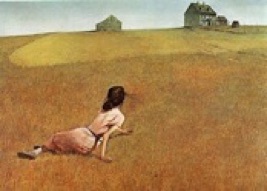
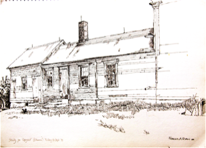
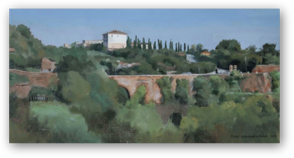
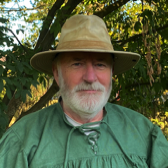
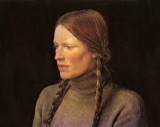

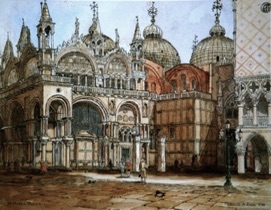
Fergus Ryan, St. Mark's, Venice
Ruslin's Stones of Venice
